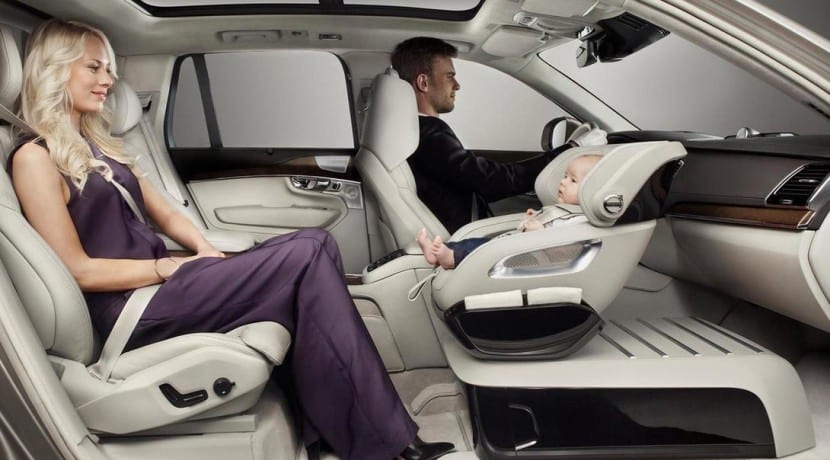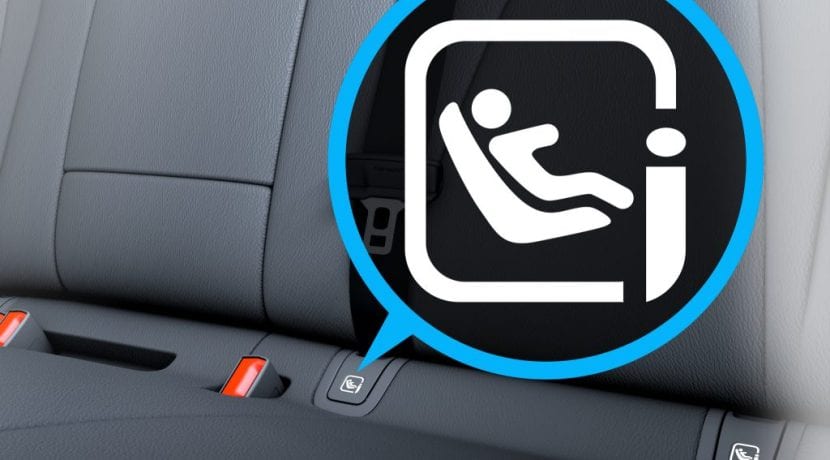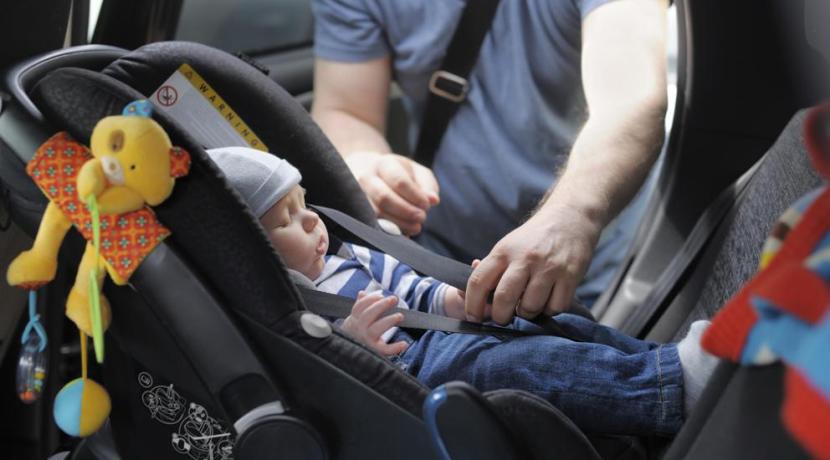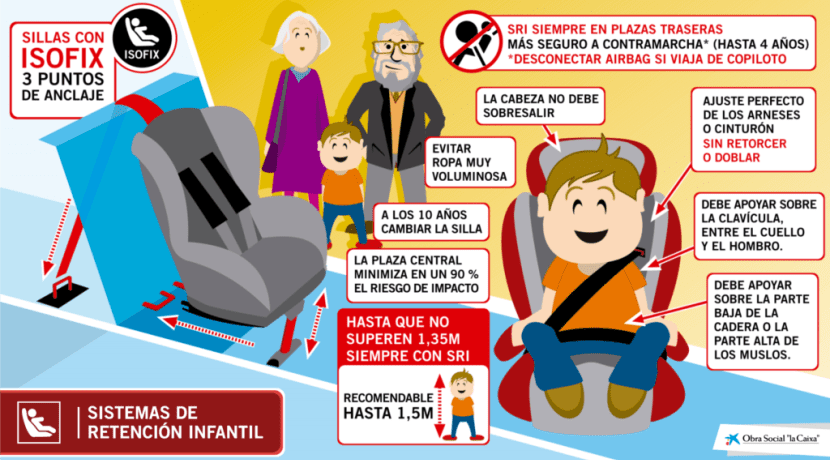
The Child Restraint Systems (SRI) they are of vital importance for the safety of children when traveling in the car. For this reason, it is important to know which are the best car seats for children that exist on the market. To do this, we must be aware of the legal regulations that affect them to know what types of CRS there are, how their safety is evaluated and how they are assembled.
Regulations for child seats

La regulations that regulates the safety of child seats is contained in two legal texts. Both documents have been prepared by the European Commission. The first is called ECE R44 / 04 and the second ECE R129 o i-size. This last document entered into force in July 2013, but in 2018 it replaced the first.
types of chairs

Groups 0, 0+, I, II and III
The legislation ECE R44 / 04 divides the different types of Child Restraint Systems (CRS) into five different groups. Two variables have been taken into account for its configuration: the weight of the child and her age.
- Group 0 and 0+: These chairs are intended for children of 0 to 15 months or a weight that reaches 13 kilos. It must go in the opposite direction to the march, as it offers greater protection for the head, neck and spine. If is one carrycot, must be placed in a transversal position and with the baby's head in the center of the carrier. The subjection must be through a five-point system, and the chair must be replaced by another of a higher group when the child exceeds 13 kilos or her head protrudes from the backrest. The use of the front seats is not recommended, except when the vehicle does not have rear seats.
- Group I: This chair is intended for children between 9 and 18 kilos or 4 years old. Your position on the sidewalk will depend on the type of seat and anchorage (ISOFIX or belt), although it is preferable that you go in opposite direction of travel. The seat must be fixed to the vehicle before mounting the child, who in turn will be secured by a five-point harness that is well adjusted to the body.
- Group II: The child's weight ranges from 15 and 25 kilos and their age ranges from 3 years to 7.
- Group III: Finally, the chairs belonging to this group are used for children from 6 to 12 years approximately, weighing between 22 to 36 kilos.

The SRIs of the Groups II y III they are mounted on the vehicle in the same direction of travel. By age, weight and size of children, they correspond to booster seats. In this case, it is more effective to use one with backup, as they provide more security. Thanks to them, the seat belt will pass over the shoulder, over the clavicle, without touching the neck. In the lower area, the horizontal band should go over the hips and thighs, never placing it over the stomach.
by heights
When the regulation ECE R129 or i-size, the chairs, in addition to being classified into groups, began to be organized according to the height of the child. Regarding the chairs approved with the previous regulations, they must pass a side impact test, In addition, all seats for children under 15 months must be placed in the vehicle in the rear facing direction.
i-Size chairs mark the range of maximum height (in centimeters) of the children who can use it. These vary between 45 and 75 centimeters, being the limit at 105 centimeters. However, in those children under 12 years of age who are less than 135 centimeters tall, they will have to use a Group II or III seat. In addition, it is recommended that they use a CRS even until they reach 150 centimeters in height.

Seats with or without ISOFIX?
There are two systems to secure child seats to the car. The first to arrive is the best known to all, that is, by using the seat belt of the seat itself. This is the most complex, since the belt strap must be inserted into different slots in the seat, and there may be slack. In addition, if the belt is unfastened, the safety of the seat, and therefore of the baby, are cancelled.
The second, and more effective and comfortable, is called ISOFIX anchorage. The ISOFIX system is the safest and most comfortable, since the seat can only be placed in one way, reducing risks. For the assembly of the SRI we must be attentive to the following anchor points.
- Two located in lower area of the sidewalk (right between the backrest and the seat). Both anchors are welded to the chassis of the car, allowing greater support in the event of an impact.
- The third point can be of two types.
- Top Tether. Anchor located in the rear area of the seat or on the floor of the trunk (on the chassis), or
- Support leg. It is a rigid supplement that goes from the lower part of the seat to the floor of the vehicle.
Car seat safety test

All the car seats for children They are evaluated through various impact tests (safety), ergonomics, use or handling and even the presence of toxic substances. Up to 30 organizations are involved in carrying out these tests, bringing together clubs such as the ADAC german he ÖAMTC of Austria or the TCS from Switzerland.
To carry out the tests, the chairs are acquired anonymous in some center where they are for sale. The tests to which they are subjected are the following:
impact (safety)
In these tests, we use vehicles from different segments and marks.
- frontal impact. To carry out this test, the seats are placed in the rear seat, both on the left and right sides. The mannequins correspond to children with a height ranging from 60 to 125 centimeters. These mannequins are exposed to a deceleration from 74 to 0 kilometers per hour in each and every one of the positions that the seats have. In the event that a CRS can be mounted in several positions or is valid for several groups, it will be evaluated as many times and with as many dummies as necessary.
- Side impact. This test is carried out by placing the mannequin (between 75 and 125 centimeters) on the chair in the right rear seat. The orientation of the CRS and dummy is that corresponding to the vehicle running. To carry out the test, between the dummy and the element that hits it, a sheet metal "door" is placed with an interior padding of 2 centimeters that is located at 80 degrees with respect to it. The impact is 27 kilometers per hour, performing as many times as necessary depending on the possibilities of the chair.
- Belt adjustment and fixing in various vehicles. Because each vehicle has cabin differently, the seats have to be evaluated in several vehicles. In this case, it is evaluated that it is well fixed in the largest possible number of cars. In addition, it is also taken into account the belt adjustment security for minors. For this test, in addition to using dummies, the help of real children may also be required.

ergonomics tests
With these tests, the TCS, ÖAMTC and ADAC technicians assess how the seats adapt to vehicles and children. For this, they use mannequins of children with different ages, weights and heights. Also, they use different types of bodies, focusing its attention on the best-selling models. Other aspects also valued are the thickness and quality of the padding, the freedom of movement in the chair, visibility or uncovered areas that can cause injuries or friction.
Tests of use or handling
This test assesses the clarity of the instruction book that accompanies the chair. Other aspects valued are the ease of installation and removal of each model, the child's comfort in fastening or how easy it is, or not, to clean it.
Toxic Substance Testing
In these tests, the organizations focus their attention on those materials with which the child seats are made. To perform the tests, they take samples of the materials of each model, and in a laboratory they analyze the degree of toxicity. The materials that focus their research are: aromatic hydrocarbons, phthalates, ignition retardants and heavy materials.
Once the tests described above have been carried out, the experts meet to prepare a ranking. The safety test accounts for 50% of the final grade, the use test 40% and lastly, the ergonomics test 10% of the total. The toxic substances test does not compute, but its results are noted in the comments of each chair.

How to choose a seat to carry the child
To choose the best car seats for children, it is best to follow these two steps. First read the car instruction book and, second, the book of the chair that we are interested in acquiring.
El vehicle book It is important, because it explains whether or not it has an ISOFIX or Top Tether system. In addition, it will also indicate where the SRI can be installed. With the reading of chair manual, we will be able to know how its assembly, placement of the child or cleaning is carried out.
In case of purchasing the child seat at a car center, ask them to install it for you. At that moment, he asks you to explain each and every one of the steps they have followed to do so. In this way, you will be able to assemble and disassemble the chair correctly when you are not with them.
Finally, taking into account both manuals, the only thing left to do is take a reference from the child and find the most appropriate one. To do this, we must look at physical complexion and age. get carried away by price, as a key factor for choosing a CRS is a common mistake, which can, in case of bad luck, result in minor injuries.

How to install a car seat
When install a seat in the car We must follow the following guidelines.
- First of all, having chosen the most suitable chair to the characteristics of the child.
- Check the fastening system of the seat to the vehicle. In this case, two alternatives can be given.
- That the vehicle does not have a system ISOFIX. In this way, to fix the SRI it will be necessary to use the car's seat belt. When assembling the chair, it will be necessary to pass the belt for all the prey on the chair. In this operation, care must be taken so that the belt is not loose. For this, it is necessary to check periodically that it has not been slackened and has not even been unbuttoned.
- If the vehicle includes an ISOFIX system. you'll just have to anchor the chair to the system checking that the green tabs on the chair are visible. In this case, you have to see, from time to time, that they have not come loose and that it is still stable.
- Anchor the chair to Top Tether hitch. If the vehicle has one, the CRS must be attached to it to prevent the chair from moving involuntarily in the event of an impact.
If the vehicle does not have a Top Tether, it is recommended to use the "support leg". This element provides more stability to the chair, helping it not to move in the event of an impact. It must be placed on the chassis, not being worth the object holder holes that some vehicles mount.
When we assemble the chair, it is important not to remove the headrest. This element prevents children from suffering from “cervical whiplash” in Groups II and III seats. Therefore, all the elements of which it is composed must be kept on the seat.

What are the safest child car seats?
To know if a SRI is safe, it is best to know the results of your tests and security tests. Since 2016, RACE has offered a website (you can go by clicking here) in which you can find out which seats are the safest with the two homologation regulations that we have commented on previously.
We leave you one comparative table of the best car seats for children what's up. The models on the list have the ISOFIX system and obtain the highest score in the toxicity tests.
| The best |

|
Car seat group 123... | See features | 194 Reviews | View deals |
| Price quality |

|
Reecle I-Size Chair... | See features | 4.659 Reviews | View deals |
| Our favorite |

|
Bebeconfort Manga i-Safe,... | See features | 595 Reviews | View deals |

|
Spiderman car seat... | See features | 3.815 Reviews | View deals | |

|
Babify Onboard Pushchair... | See features | 6.439 Reviews | View deals | |

|
Toral Child Car Booster... | See features | 60 Reviews | View deals |